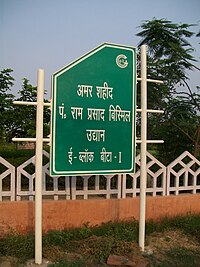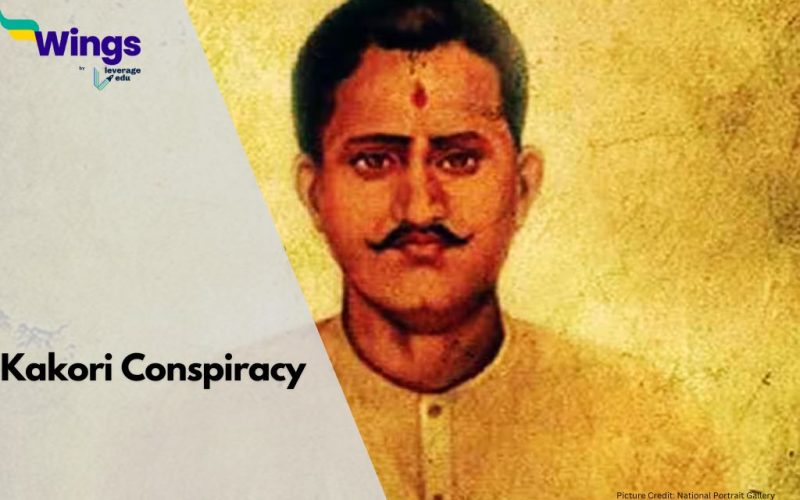There are numerous chapters in India’s struggle for independence that stand strong amidst the cruel colonial waves of oppression. Among others, the Kakori Conspiracy is one of the most famous revolutions that are the epitome of India’s unwavering determination to seek freedom. It included numerous famous personalities out of which many lost their lives during the trials. In this blog, we will explore the intricate details of the Kakori Conspiracy, its objectives, the people involved, and more.
Also Read: Indo-Pak War 1965: Highlights, Dates & Outcomes
Kakori Conspiracy
The famous Kakori conspiracy or Kakori Kand happened on 9th August 1925. On this day, members of the Hindustan Republic Association (HRA) attempted to rob a train at Kakori station which is located near Lucknow, Uttar Pradesh. The brainbox behind this conspiracy was Ram Prasad Bismil. Apart from his, this conspiracy consisted of numerous other prominent participants such as Chandrashekar Azad, Keshab Chakravarty, Roshan Singh, Ashfaqulla Khan, and Rajendra Lahiri.
The motive behind this robbery was to loot the government treasury and obtain the funds and resources required to purchase arms and ammunition. These weapons would then be used for launching armed attacks against British forces and other revolutionary activities. As the train approached Kakori station, the men of this organization tried to stop and loot it.
Among the hustle and bustle of this robbery, a passenger was shot accidentally, which infuriated the already tensed British soldiers.
This significant attempt to rob the British forces of their treasury stirred the hearts of common people throughout the nation. Many people started rebelling against the forces and led their freedom struggles. Soon after the somewhat successful Kakori conspiracy, the administration started searching for the people responsible for this chaos. They managed to arrest around 40 people and accused them of different offenses.
Also Read: Evolution of the Indian Flag: All Phases
Objectives of the Conspiracy
By now you must have understood that the looters involved in the Kakori Conspiracy were members of the Hindustan Republican Association. Here is an overview of the objectives of the famous Kakori train robbery:
- To obtain the necessary funds for new arms and ammunition.
- To generate a positive image of the HRA among Indian citizens.
About Hindustan Republican Association (HRA)
The Hindustan Republican Association was among the most popular revolutionary parties in India. Constituted by Ram Prasad Bismil and his associates, this association aimed to fight against the oppressive British rule in India. It is believed that the main reason behind HRA’s formation was Gandhi calling off his famous non-cooperative movement in 1922.
Here are a few other interesting facts about the Hindustan Republican Association:
- The Hindustan Republican Association was initially known as the Hindustan Socialist Republican Association.
- It involved numerous prominent leaders such as Sachindra Nath Sanyal, Bhagat Singh, and Chandrasekhar Azad.
- The HRA centers were located in different cities throughout the country such as Varanasi, Saharanpur, Lucknow, Allahabad, and Shahjahanpur.
- It is believed that the HRA had bomb manufacturing units at Deogarh and Calcutta.
- The manifesto for the Hindustan Republican Association was written by Sanyal and was named Revolutionary.

Also Read: Carnatic War Chronicles: Battles and Results
Kakori Conspiracy Trials
The judicial proceedings for the Kakori Conspiracy case started on 21 May 1926. It included cases against 28 highly active members of the Hindu Republican Association. At this time, the public prosecutor for the British Crown was Pandit Jagat Narayan Mulla. The judge was assisted by Abbas Salim Khan, Mohd. Ayuf, Gyan Chattarji, and BanvariLal Bhargava. After this incident, most of the involved members escaped to Lucknow. Although the British forces were unable to capture Chandrashekhar Azad, he killed himself after being gruesomely injured at Chandrashekar Azad Park during a shootout on 27 February 1931. Around 40 freedom fighters were arrested and charged with different allegations for being a part of the Kakori Kand. Although Ram Prasad Bismil defended his own case, here is a list of the lawyers included in these proceedings:
- Gobind Ballabh Pant
- Chandra Bhanu Gupta
- Gopi Nath Srivastava
- R. M. Bahadur ji
- Kripa Shankar Hajela
- B. K. Chaudhury
- Mohan Lal Saxena
- Ajit Prasad Jain
The final decision of the Kokari Kand was announced in July 1927. Accordingly, the court acquitted around 15 people due to the lack of evidence against them. Moreover, the death sentence was awarded to a few of them including:
- Rajendra Lahiri
- Ram Prasad Bismil
- Thakur Roshan Singh
- Ashfaqullah Khan
Also Read: Third Carnatic War: Causes, Battles and Impact
Kakori Conspiracy Legacy
The Kakori Conspiracy was more than a loot for money and resources. Instead, it reflects the country’s relentless pursuit of independence. This incident served as a ray of light amidst the dark clouds of injustice. It gave other citizens the courage and strength required to unite and stand against British rule. The bravery and sacrifices of the involved, also referred to as the Kakori martyrs, continue to be celebrated as a symbol of the undying spirit of freedom.
Apart from this, some detained revolutionaries such as Shachindra Nath Sanyal and Sacindra Bakshi were sent to deportation to Cellular Jail located in Port Blair, Andaman & Nicobar Islands. Ram Prasad Bismil was hanged on 19 December 1927 at the Gorakhpur Jail, Roshan Singh at Naini Allahabad Jail, and Ashfaqulla Khan at Faizabad Jail.
 One app for all your study abroad needs
One app for all your study abroad needs













